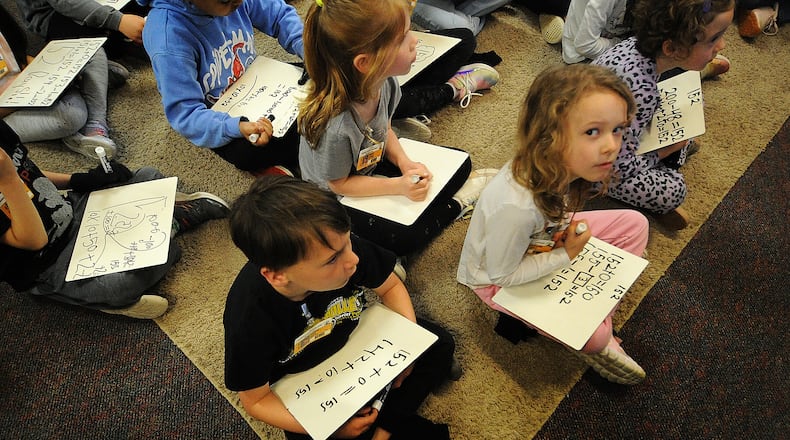The reason for this is largely demographic, local experts say. The impact could be felt for years to come.
| Change in enrollment for local school districts over five years | ||
|---|---|---|
| School District | 2023-2024 enrollment | Difference from 2019-2020 school year |
| Dayton | 12,523 | 0.45% |
| Hamilton | 8,760 | -9.70% |
| Centerville | 8,075 | 0.15% |
| Kettering | 7,718 | -2.94% |
| Beavercreek | 7,765 | -1.33% |
| Springfield | 7,215 | -5.60% |
| Middletown | 5,720 | -3.50% |
| Huber Heights | 5,798 | -1.50% |
| Springboro | 5,766 | -1.23% |
| Lebanon | 4,951 | -6.30% |
Nationwide, enrollment in traditional public schools is expected to drop by about 6%, and private school enrollment in 2030 is expected to be lower than it was in 2019.
Ohio Department of Education and Workforce data shows enrollment at public schools across Ohio, including charter and traditional public schools, has dipped 2.8% from the 2019-2020 school year to the 2023-2024 school year. While private school enrollment and students being homeschooled rose in the same time frame, the change doesn’t fully explain why there are fewer students now compared to 10 years ago.
But not all local school districts saw a decline in enrollment. Centerville and Dayton public schools are the two largest districts in the region that are seeing growth among their students in the last four years, though both have seen small increases. Dayton Public’s enrollment grew about half a percent between the 2019-2020 school year and the 2023-2024 school year, while Centerville’s grew 0.15% in the same time frame.
Why is this happening?
A major reason enrollment has dropped is a lower birth rate. According to the Centers for Disease Control, the number of live births per 1,000 women decreased from 13.5 in 2009 to 11.4 in 2019, due to social changes, higher education and more access to contraceptives for women.
Fewer births means there are now fewer school-aged children.
“All the demographic factors with reduced childbirth rates, sort of a stagnant general population in Ohio just means there are fewer kids to educate,” said Aaron Churchill, Ohio research fellow at the Fordham Institute, which closely tracks where Ohio’s kids are going to school.
During the earlier years of the pandemic, kids stopped going to school. Not all those kids returned.
In the 2019-2020 school year, there were more than 1.9 million students in the state, across public, private and home schools. In the 2023-2024 school year, there were about 1.89 million across all three school forms, resulting in about 20,577 fewer students.
Shannon Cox, the Montgomery County Educational Services Center superintendent, said the MCESC started looking into the demographic change to try to figure out where the kids went. She said they found about the same number of families living in the area.
“So where did they go?” Cox said. “We’re not really sure. It’s one of those things that’s still not a definite answer, that we can just put a finger on it.”
Cox said one way to predict a future increase in enrollment at any local school district is to see where homes are being built. There are more developments planned in Centerville and Washington Twp., and a proposal for homes in Miamisburg.
New school buildings can also bring more people into a district, she said.
Dayton increases
The half a percentage growth, while small, in Dayton Public is a big deal since the district has been steadily losing students since the 1970s, when DPS first began integrating students between traditionally Black and traditionally white public schools.
An additional challenge to Dayton’s enrollment came in the early 2000s, when charter schools first popped up in Ohio. These schools are not run by an elected board of government, the way a traditional school district is, and typically are run out of older buildings that are no longer used as schools, strip malls or other space as it can be used. Around the same time, Ohio expanded vouchers to allow any student in a “failing” school to attend outside of their district on a scholarship, which included all of Dayton Public Schools. These changes were made because Dayton Schools were widely considered to not adequately educate the city’s kids.
Currently, only about half of the kids who live in Dayton attend Dayton Public Schools.
Dayton Public superintendent David Lawrence said he thought the recent change in the way the district presented itself, along with a change in leadership, helped improve enrollment. Lawrence, who became the official superintendent early in 2024, said more students have enrolled this school year, and he expects that trend to continue.
“I think there’s a change in the way we present the district itself,” Lawrence said. “I think there’s a change in our core values, in terms of being around customer service and attracting people back here.”
Suburban changes
Beavercreek, Centerville and Kettering have all had roughly similar enrollments for decades, but the modest growth of 0.15% has made Centerville the largest of the three, according to state data.
Centerville has now outgrown Kettering, which was the second-largest school district in the region for decades. Kettering, by contrast, has seen declining enrollment between the 2019-2020 school year and the 2023-2024 school year.
“Staying on top of enrollment numbers is important so that we can make sure our staffing is where it needs to be to meet the needs of all students,” said Kari Basson, spokeswoman for Kettering schools.
According to ODEW numbers, Beavercreek has lost 1.33% of enrollment between 2019-2020 and 2023-2024. However, the district says its enrollment has increased by 227 students in the same time frame.
Beavercreek officials said this is because it has an increased number of students at least partially enrolled at the Greene County Career Center. They said for those students, the state’s enrollment calculation partly allocates the students to the Career Center and partly to Beavercreek, which makes the district’s total number seem smaller than it actually is.
The district said Beavercreek is in fact serving more students each year, not less.
Springboro schools, which has about a thousand fewer students than Beavercreek, saw a 1.23% decline in enrollment between 2019-2020 and 2023-2024 school years.
Sarah Swan, a spokeswoman for Centerville schools, said the district has continued to see more new construction and growth, which has kept enrollment steady. There have also been changes as homes are sold to young families, she noted.
“We are currently utilizing the available classrooms in our schools,” Swan said. “Right now, we are not planning any changes to our attendance zones, but we are always monitoring enrollment at the grade level, school building, and district levels.”
Before the 2022-2023 school year, there was redistricting as John Hole Elementary and Magsig Middle School were both over capacity, she said.
Two smaller districts have seen big increases in enrollment since the 2018-2019 school year. Bethel Local Schools, just north of Huber Heights, has seen the highest increase in enrollment in the area among traditional public schools at almost 22%. And Northridge schools, another smaller district, has seen a 2.5% increase in enrollment between 2019-2020 school year and 2023-2024.
In Oakwood, between 2019-2020 and 2023-2024, the district’s enrollment fell about 4% to 1,993 students last school year.
Butler, Clark counties
Springfield’s enrollment has continued to fall, even with more immigrants in the city. The district lost 5.6% of its enrollment between the 2019-2020 school year and the 2023-2024 school year.
A district spokeswoman said Springfield has maintained relatively stable enrollment since the 2019-2020 school year, around 7,200 students. But, due to a high level of poverty in Springfield, it is more likely that the students would move around. Earlier this year, about 600 students or about 8% of the population were frequently entering or exiting the district.
“Beyond the challenges posed by poverty, the city also faces an aging population and a limited family housing stock, both of which negatively impact the district’s potential for enrollment growth,” the district spokeswoman said. “Unlike suburban districts that may experience increased enrollment due to the development of new subdivisions or a younger median population age, the Springfield City School District is less likely to benefit from these demographic shifts.”
Hamilton has seen one of the largest declines in enrollment in the area, losing 9.7% of enrollment between 2019-2020 school year and 2023-2024 school year. The district did not return a request for comment.
While more families are choosing to send their children to private school or to homeschool them, that increase doesn’t fully explain why there are so many fewer kids in public schools now compared to 10 years ago.
In 2014, the Ohio Department of Education and Workforce recorded 175,667 students in Ohio’s private schools. In 2024, there were 173,156 students in Ohio’s private schools. The year 2024 saw an increase from fall 2021, when the state recorded 162,917 students in private schools, the lowest recorded enrollment in private schools between 2014 and 2024.
Homeschooling has also become more popular after the COVID-19 pandemic. ODEW recorded 30,923 students who were being homeschooled during the 2017-2018 school year, compared to 53,051 students in the 2023-2024 school year.
Why does it matter?
Could fewer students in local schools mean lower taxes? Not exactly.
The laws governing how much money the state provides for local schools are complicated and depend heavily on how much wealth each district is judged to have. Districts like Oakwood and Centerville are expected to shoulder much of the burden of paying for their schools, while a district like Dayton is funded more heavily by the state.
Churchill said enrollment changes could impact class sizes, staffing and class offerings. Fewer kids with the same number of teachers would mean smaller class sizes. But if a district decided to cut teachers because of fewer students, class sizes could go up.
To feasibly offer more niche classes in high school, like an Advanced Placement course, more students are required to make it worthwhile. A drop in enrollment could mean some of those classes are cut, he said.
“If you’re just sort of losing high school students every year, there might not be enough kids to economically make it work for some of those specialized programs,” Churchill said.
Cox said in the long-term, fewer kids in schools could mean fewer workers to fill Ohio’s jobs.
“If they’re not coming from the students or the potential workforce that we already have, then where are they going to come from?” she said.
About the Author

